A nation must think before it acts.
Introduction
I arrived in Kyiv this July after a thirteen-hour overnight train ride in a clean but austere Soviet-era railway car. Since I couldn’t purchase a return ticket in Poland, immediately upon arrival at the train station I went to the international ticket counter and enjoyed the old Soviet practice of queuing. For almost an hour the ticket clerk shuffled paperwork in front of a clamoring crowd, which she ignored. When she finally started waiting on her customers, I received my turn half an hour later and was rudely informed that the tickets I wanted were only sold on-line and were sold out.
Realizing the futility of arguing, I moved through an ensemble of taxi drivers and streetwise money changers hectoring for my business to find a currency exchange kiosk. The money changer, whose service etiquette harkened back to the Brezhnev era, rejected several bills due to the tiniest of tears or other disqualifying marks. When I finally had enough cash for a taxi ride and breakfast, I walked across the railway station plaza to a rundown building housing a McDonalds.
Doing so, I reflected on my experiences in post-Soviet states in the 1990s and felt that I had just traveled back in time to that era. However, approaching the clean, well lit McDonalds counter, I was greeted by a young lady with a smile, helpful attitude, and quick and efficient service. After an exhausting trip, I was overjoyed.
Those initial two hours of my first trip to Ukraine were the beginning of many experiences that would teach me how this country is evolving from its Soviet past to a new future. During my travels I encountered many other juxtapositions between Soviet-era and Western practices. The impression that I gained was that of a country moving away from the railway station ticket counter to the counter at the McDonalds. This paper, while primarily a politico-military analysis of a horrible war, will hopefully also present that view to the reader as well.
This paper will update my previous analysis[1] of the Russo-Ukraine War based on the events of the past fourteen months, including observations and conversations during a recent trip in mid-July 2023 to Kyiv. It will review the major shifts in the military situation since June 2022; discuss how Russia and Ukraine are gearing for a long war; provide an overview of current war aims and strategies to achieve them; discuss likely scenarios for the war over the next year; and examine the key role of Russian-occupied Crimea. The paper’s conclusion will explain the significance of these factors, and possible opportunities, for the security of the United States.
In June 2022, I wrote that Russian war aims had contracted from subjugating Ukraine to expanding the territory of the breakaway statelets it supposedly went to war to protect. By contrast, Ukraine’s war aims had grown from survival to recovery of all territory lost to Russia since 2014. These uncompromising objectives, the paper predicted, would lock Russia and Ukraine into a war of attrition with little hope of a negotiated settlement. In the fourteen months since that article, I see no change in the overall politico-military situation and no possible negotiations to end the war except for terms that a victor will provide the vanquished. The mutual investments in blood and treasure, and fears that losing the war means either losing power or independence, means the only way to end the war is for one side’s military to impose its will on the other. The only question is who will be the victor and vanquished in this war and what that will mean to the safety and security of the United States.
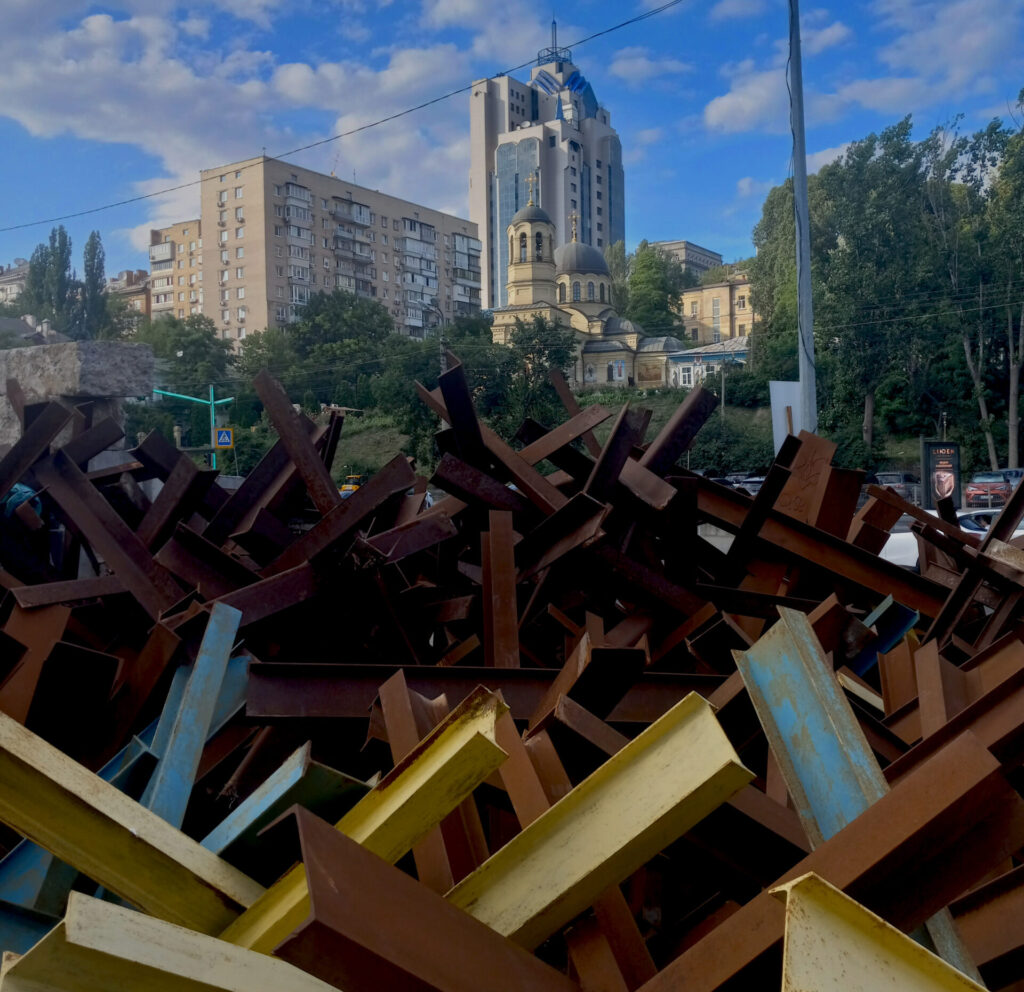
Kyiv, July 2023. A collection of steel anti-tank obstacles serve as an informal memorial to the first days of the war when they were used to block the capital’s streets against an expected Russian tank assault or as a supply point in case they are ever needed again. (Philip Wasielewski)
Key Findings
- Both the Kremlin and Ukrainians see the war as an existential conflict, even as a “holy war,” and are prepared to fight for years to achieve victory.
- Russian war aims vis-à-vis Ukraine have morphed into creating a “frozen conflict” to maintain its land bridge with Crimea. However, its primary war aim remains weakening NATO to regain its sphere of influence in the former Soviet republics and Warsaw Pact states. To achieve this, Russia will conduct a prolonged strategic defense in Ukraine to demonstrate that Ukraine will never regain its territorial integrity and to show that American support will eventually end as it has for other client states.
- Ukraine’s primary war aim of restoring its territorial integrity is shared across its society. To achieve this, Ukraine’s strategy is to break the will of the Russian army and then reclaim Crimea, even if that takes several years.
- Ukrainians do not fear a long war but an inconclusive one that reignites in five or ten years. They want to settle this conflict with Russia once and for all, and see NATO membership as the only way to prevent it from happening again.
- For US policymakers, the dangers arising from the war overshadow opportunities. One opportunity is a Russian defeat that can serve both as a brake against further Kremlin aggression and as a catalyst for Russia to possibly change her imperial identity. Another opportunity is the chance to strengthen NATO’s conventional forces and geographic position to give it an overwhelming advantage against any possible future Russian aggression. For that to happen, Ukraine must enter the alliance.
The View from the Ground
By June 2022, the military situation in Ukraine had improved for Kyiv. Russia withdrew its forces from northeastern Ukraine to reinforce its attacks in the south and southeast. The Donbas offensive provided Russia with some tactical successes and propaganda victories (e.g., Severodonetsk and later Bakhmut) but not a strategic one. Ukraine counterattacked in the early fall reoccupying Kupyansk and Kherson but this operation quickly reached a culminating point due to a lack of reserves and the equipment necessary to cross the Dnieper River. Russia mobilized approximately 300,000 men for its ground forces and mercilessly fed them into the fighting. General Sergey Surovikin took control of Russian forces, stabilized the front, and began constructing a series of fortified lines to protect Russia’s land bridge with Crimea.
President Vladimir Putin, however, disagreed with the idea of a strategic defense. He relieved Surovikin, and replaced him with the Chief of the Russian General Staff Valery Gerasimov who decided to make the crossroads town of Bakhmut the focus of a Verdun-like strategy to attrit the Ukrainian army. While Russia fought the battle of Bakhmut as its main effort, Ukraine fought it as an economy of force operation. Ukraine lost the town after nine months but gained time to create new mobile forces with Western equipment. Simultaneously, Russia gained time to complete the Surovikin line. However, it was the Russian army that was attrited at Bakhmut, especially its elite airborne forces and the mercenary Wagner Group, leading to serious morale problems. Wagner, led by its mercurial leader Yevgeny Prigozhin, staged an abortive mutiny in July 2023 and for the time being has been removed from Russia’s order of battle in Ukraine.
As Russia’s offensive culminated with seizing Bakhmut in late May 2023, Ukraine counterattacked. Ukraine forces are attacking in Zaporizhzhia and Donetsk oblasts along three axes. The first is from Orikhiv towards Melitopol; the second is from Velyka Novosilka along the Mokri Yaly River towards Berdyansk and/or Mariupol; and the third is around Bakhmut. Russian forces are conducting spoiling attacks in Luhansk oblast from their defenses near Svatove and Kreminna to fix Ukrainian forces in place and prevent them from joining the main effort.
Today, the world’s attention is fixed on Ukraine’s counteroffensive and whether it will shift the strategic correlation of forces for this war. As many have observed, Russian fortifications have slowed Ukraine’s attacks due to their depth, the surrounding terrain that provides long range fields of fire for anti-tank guided missiles, the immense number of mines laid in front of them, and the limited numbers of combat engineers and combat engineering equipment on the Ukrainian side. Ukrainian military experts note that Russia was able to build these lines because of Ukraine’s limited long range strike capabilities, both in missiles and aircraft, to disrupt these efforts. A debate in the Ukrainian military last winter whether to strike south sooner with forces available or wait until new units could be created with Western military equipment was resolved in favor of the latter approach. As of August, Ukrainian forces are attempting to find weak spots in the defensive lines and penetrate their various echelons in order to unleash mechanized reserves into the Russian rear and sever their lines of communication to Crimea.[2]
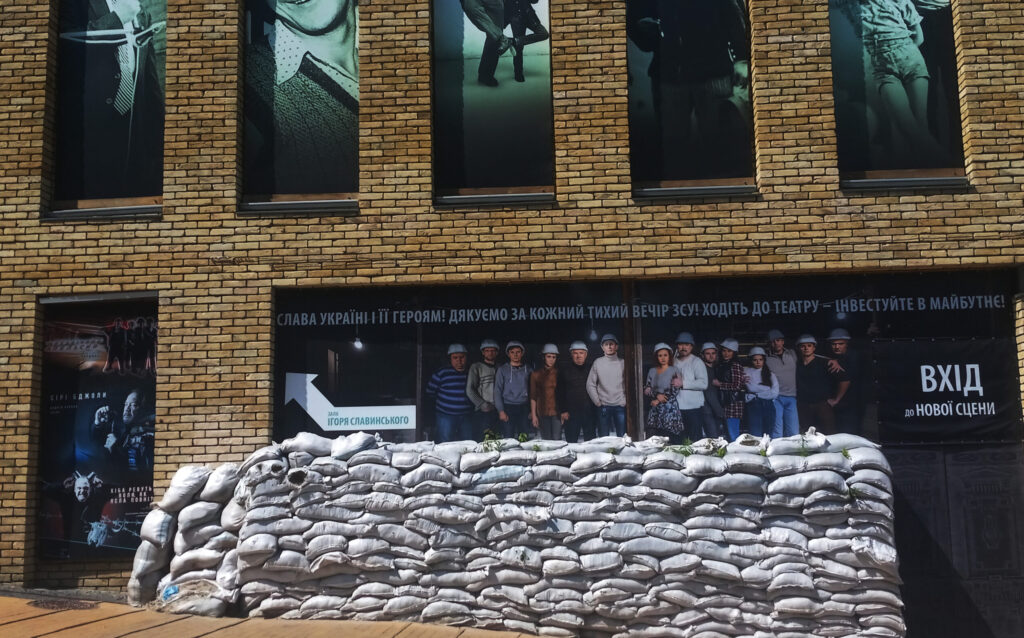
Sandbags protect a theater in Kyiv that is open for business. The sign on its front reads, “Glory to Ukraine and her heroes! We thank the Armed Forces of Ukraine for every quiet evening! Come to the theater – invest in the future!”(Philip Wasielewski)
Preparing for a Long War
Increasingly, Russia and Ukraine believe they are fighting an existential and even a “holy” war. Moreover, both sides are preparing to fight indefinitely until their war aims are achieved.
The View from the Kremlin
The term existential has become overused; but in describing the war in Ukraine, it is an accurate description of how the Kremlin perceives it. Putin is a student of Russian history and aware of the connection between failed wars and leadership changes. He has even publicly warned of the possibility of the history of 1917 repeating itself, a reference to the year of two revolutions that toppled a Tsar and Provisional Government.[3]
In authoritarian countries like Russia, it is hard to accurately gauge a society’s support for a war. Anti-war protests early in 2022 were quickly suppressed as was what was left of Russia’s independent media and political opposition. Most who opposed the war or feared serving in it have already fled and there has been a paucity of open dissent.
The Russian government has used television and the Russian Orthodox Church to promote the war. Russian television offers daily broadcasts with a litany of anti-Ukrainian, anti-Western, and pro-war messages. The Russian Orthodox Church has literally blessed the war and disciplined dissenting clergymen. Both the media and the Russian Orthodox Church echo the narrative that this is a war not just against Ukraine but against the West, which is characterized by both secular and religious commentators as “satanic.” Patriarch Kirill preaches that, “sacrifice in the course of carrying out your military duty washes away all sins,” sees Russia’s invasion of Ukraine as a bulwark against a decadent West, and insists that “Russia has never attacked anyone.” Numerous figures from former Russian president Dmitry Medvedev to television host Vladimir Solovyov have used the term “holy war” to describe the conflict. This is the regular discourse that the average Russian hears daily from television and on Sundays from the pulpit (although less than 10 percent of Orthodox Russians are regular church goers).[4]
The greatest threat to Putin over his handling of the war comes from the ultra-patriotic right and accounts for the recent repression of those complaining about his leadership in the wake of the Prigozhin mutiny. Putin has to date balanced the need to mobilize Russia’s society and economy for the war while also shielding both as much as possible from the conflict to reduce the risk of social unrest. How long this will be possible is unknown. There are reports that the Kremlin may need to conduct a second mobilization for a prolonged war and despite relatively rosy International Monetary Fund projections, many observers expect a worsening economy as embargoes and limitations on Russian energy sales instituted in late 2022 take greater hold.[5]
In Kyiv, I found that some Ukrainian observers do not believe that sanctions will slow the Russian war machine. Andriy Klymenko, a member of Ukraine’s Black Sea Institute of Strategic Studies, believes Russia can and will sustain a long war. He says that it is impossible to seal off imports to a country like Russia with its immense borders and its allies helping avoid sanctions on energy sales and computer chips. He also believes that the imperial mindset of Russian officials, intellectuals, and even its poorer citizens will sustain the war at least into 2024.[6] Mykhailo Gonchar, president of Ukraine’s Center for Global Studies, agrees that Russia will be able to economically support the war for several years, noting that energy revenues from 2022 allowed Russia to increase defense spending in 2023 and that this will continue.[7]
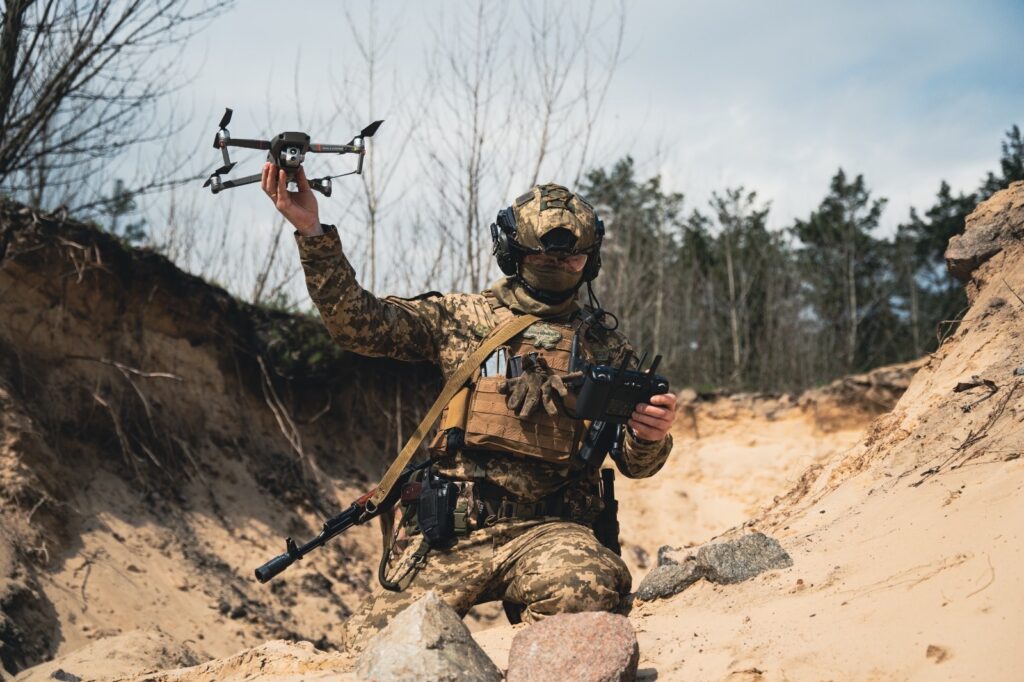
Bakhmut, Ukraine.- In photos taken on July 10, 2023, members of the Ukrainian Armed Forces are deployed in the midst of the conflict with Russia. The Ukrainian army reported that its troops have so far retaken 169 square kilometers (more than 65 square miles) on the southern front and 24 square kilometers around the eastern city of Bakhmut since their counteroffensive began last month. (Reuters)
The View from Kyiv
Ukrainian society also views the war as existential. Most Ukrainians, witnessing war crimes in occupied territories, knowing of attempts to destroy the Ukrainian language and culture there, and undergoing daily attacks, believe that the Russians are fighting a genocidal war against them. Speaking directly with Ukrainian citizens during my visit, I came away with several clear impressions of how they see the war and are reacting to it.
The first is a distinct fear that defeat means losing their independence and national identity, and a determination not to let this happen. Closely following this is the impression that as a result of this war, Ukrainians of all backgrounds are developing a common national identity that has eluded them for the first thirty years of the country’s independence. Differences between the predominantly Ukrainian-speaking western part of the country and the predominantly Russian-speaking eastern and southern parts have diminished in the face of a common threat. The fact that Russia has visited the greatest amount of death and destruction on Ukraine’s Russian-speaking eastern and southern areas accounts for closing much of this gap.
Second, attacks against civilian targets strengthen Ukrainian resolve and reinforce to the average citizen what they are fighting for and against. This common danger has been another unifying force. Still, it comes at a cost. Most Ukrainians have themselves or know of those who have suffered death, injuries, or property destruction. The war has affected everyone. Ukrainian society is fatigued by war and fear and suffers at many levels, including cases of post-traumatic stress for civilians as well as soldiers. One lady, who worked at a suicide prevention hotline, told me that many people suffer but no one has yet to speak to her about wanting to give up in order to end the war.[8]
Third, Ukrainians are not blasé about the possibility of a nuclear strike on the battlefield or a city or the sabotage of Zaporizhzhia nuclear plant, but are not deterred by Russian nuclear threats and believe they have no choice but to persevere in their fight or be destroyed as a nation. As another interlocutor told me, “We are adapting to the war because we have no choice but to adapt.”[9] It was clear from conversations across a wide swath of Ukrainian society that the average citizen is mentally preparing for a long war because they respect Russia’s size and capabilities but also are fighting for the goals President Volodymyr Zelensky has articulated—the return of Ukraine to its internationally recognized 1991 borders. They are past any possibility of compromising with Russia and want Crimea back even if it takes several more years of fighting.
Fourth, both military and civilian interlocutors note the great moral authority that the Ukrainian military has gained from the war and say that as long as the military is fighting, society will support them. They do not fear a long war but an inconclusive one that reignites in five or ten years. Ukrainians want to settle this conflict with Russia once and for all and see NATO membership as the only way to prevent it from happening again.
Finally, Ukrainians are fully aware of Western support and extremely thankful for it. They acknowledge that even with the bravery of their military, they cannot fight this war without Western support. While they are not concerned about the staying power of Ukrainian society, they are concerned about the staying power of the United States. Their greatest nightmare is an agreement over their heads by the United States, Russia, and China. Ukrainians are also concerned that Russian disinformation, which places blame for the war on Ukraine, will be believed and that inflation and other economic problems in neighboring countries caused by the war will diminish their support. The average Ukrainian is well informed about domestic politics in Western countries—especially the United States—and recognizes that the longer a war lasts, the more important allies and resources become.
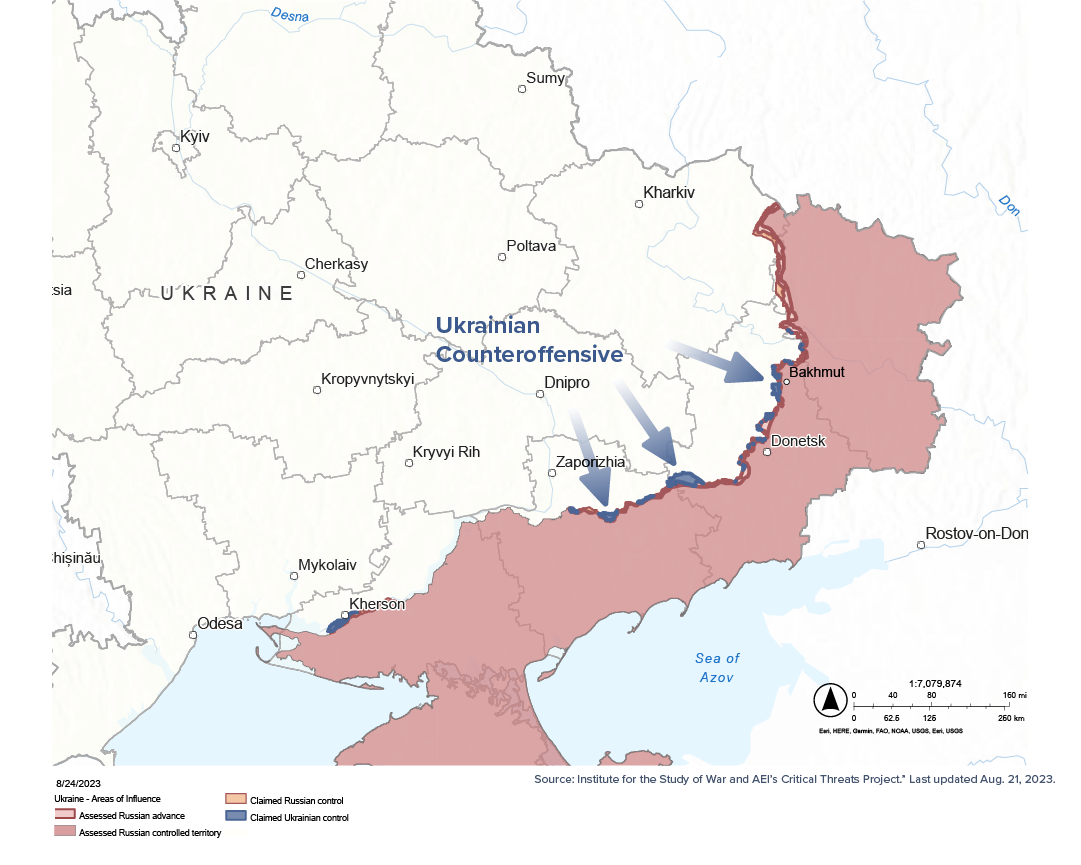
Assessing Russian and Ukrainian War Aims and Strategies
Russia
Russia’s initial war aims, infamously expressed as “denazification and demilitarization,” were only partly about making Ukraine its vassal. Moscow’s primary aim was to eject American power from its former Soviet sphere of influence. As Russia massed its troops on Ukraine’s borders, its demands were directed at the West and not Kyiv. On December 17, 2021, Russian Deputy Foreign Minister Sergey Rybakov demanded written guarantees that Ukraine would never join the NATO alliance; NATO troops would be withdrawn from all former Warsaw Pact states; NATO would end military cooperation with Ukraine and Caucasian and Central Asian states; and America would withdraw its nuclear weapons from Europe. Ignoring Kyiv, the Russian Foreign Ministry put forward two draft treaties, one for NATO and one for the United States, and Rybakov called for Washington to act quickly and suggested a meeting in Geneva the next day to begin negotiations on Russia’s demands.[10]
When this diktat was not accepted, Moscow attempted a coup de main of rapidly advancing armored and airborne units to seize Kyiv and other cities, decapitate the Ukrainian government, and activate a Fifth Column of collaborators. This strategy hoped to replicate the successful Soviet coup de main operations in Czechoslovakia in 1968 and Afghanistan in 1979. Its instigators failed to remember the more recent failure of this strategy in Chechnya in 1994.
When it was evident that these war aims were unachievable, Moscow unofficially shifted its goals vis-à-vis Ukraine to the complete occupation of the Donetsk and Luhansk oblasts in eastern Ukraine and the institutionalization of Russian rule in occupied southern Ukraine. Using a strategy of attrition to destroy the Ukrainian army, it launched an offensive into the Donbas, which never achieved its aims.
Moscow’s larger objectives vis-à-vis NATO and American power never altered. The most recent announcement of Russia’s war aims coincided with the NATO Summit in Vilnius. On July 12, 2023, Russian Foreign Minister Sergey Lavrov repeated in an interview that Russia’s war aims were the protection of the population of Donbas; the demilitarization and denazification of Ukraine (i.e., regime change); and the elimination of security threats that emanate from the territory of Ukraine.
Lavrov claims that in negotiations between February and April 2022, Ukraine agreed to never join NATO and confirm its nuclear free status, and insists that Kyiv accept those criteria and acquiesce to the incorporation of occupied territory into the Russian Federation.
The key parts of Lavrov’s interview were not the repetition of Moscow’s maximalist position but remarks regarding the “stubborn desire of Kyiv and its Western curators to escalate hostilities,” and how the West had “arrogantly rejected” Russia’s desire for security guarantees on its western borders. Lavrov made clear that, “the aggressive steps of unfriendly states pose an existential threat to Russia. There is no doubt about it. We will have to defend our right to free and sovereign development by all available means … This is about the collective West.”[11]
These remarks demonstrate two key points of Russia’s war aims. First is the imperial belief that Ukraine has no agency, the ability to make one’s own decisions, and therefore is nothing more than a Western puppet. Second, Moscow believes this war is rooted in Western aggression against Russia for which Ukraine was only an instrument.
Therefore, Russia remains focused on its overarching strategic goal to diminish American power and believes it can achieve this goal by attacking US resolve. To do so it has shifted its military strategy to a strategic defense. Moscow’s goal is to attrit Ukrainian forces and hold onto as much territory as possible so Washington loses hope that Ukraine will regain its full territorial integrity. The Kremlin’s aim is to create a “frozen conflict,” which it could claim as a victory by securing a land bridge to Crimea and demonstrating the limits of Western, specifically American, resolve. Russia’s strategy now is not to outlast Kyiv but Washington.
This is also a strategy of nihilism (i.e., deterrence by punishment) which prevents an opponent from acting because the costs are too high. In the Kremlin’s mind, the destruction of Ukraine’s economy and cities, the decades-long consequences of mines and unexploded ordnance in her fertile fields, and the uncertainty of the whereabouts of millions of her citizens in the occupied areas (many deported to Russia, especially children) will serve as a warning to its neighbors, NATO members or not, about what happens to those who anger Moscow. If this strategy works, if a lack of support creates a “frozen conflict” in Ukraine, it could begin a process of splitting the NATO alliance as Washington will be seen as being self-deterred by a combination of fears of the possible Russian use of nuclear weapons or that Russia will dissolve and lose control of those weapons. A frozen conflict would recall Thucydides’ Melian dialogue of 2,400 years ago that the strong do what they can and the weak suffer what they must. Its example could also motivate smaller states worldwide to bandwagon with ruthless dictatorships rather than to balance with the United States—to the detriment of the United States.
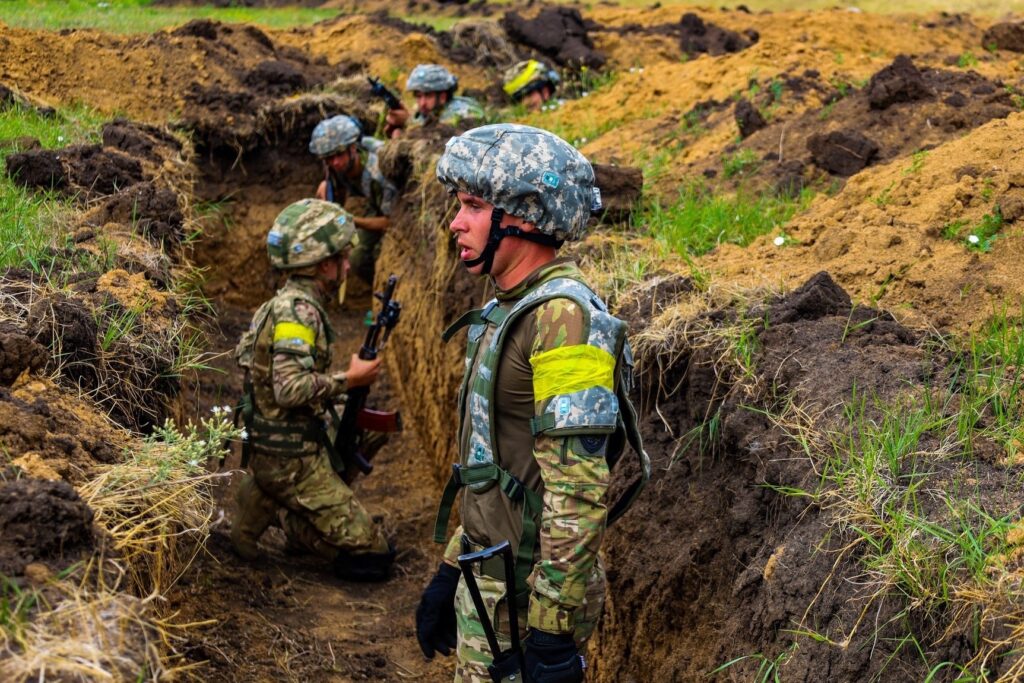
Bakhmut, Ukraine.- In photos taken on August 10, 2023, members of the Ukrainian Armed Forces are deployed in the midst of the conflict with Russia. In the east, due to the multilevel air defense of the Ukrainian defenders, Russian aviation cannot operate over the Ukrainian positions, so the offensive continues in the direction of Bakhmut. (Latin America News Agency/REUTERS)
Ukraine
In early June 2023, I interviewed Major General Borys Kremenetskyi, the Ukrainian Defense Attaché in Washington. He said Ukraine’s definition of victory was regaining its territorial integrity to the internationally agreed upon borders of 1991; using frozen Russian assets to pay for reconstruction in Ukraine; obtaining justice and accountability for Russian war crimes in Ukraine; and entering NATO to provide security for the future.
To achieve this first goal, Ukraine can pursue two types of military strategies; one focused on seizing territory or one focused on destroying the enemy’s army. As Ukrainian forces attack towards Crimea, the Azov Sea, and Bakhmut, it seems that they are pursuing a territorial-focused strategy. However, if one looks at Ukrainian military operations across the entire theater, we see a more complex enemy-focused strategy at work. Ukraine has concentrated its limited deep strike assets on Russian logistics, command and control, fire support, and reserve formations. By preventing fuel, ammunition, food, and replacements from reaching the front lines, Ukraine’s strategy attempts to undermine both Russian army capacity and morale. Operations near Bakhmut are a part of this strategy. Ukrainian military officers say their goal is to force the Russians to abandon the city. Russia’s loss of Bakhmut would be a minor Ukrainian tactical victory but a major psychological one and a major psychological blow to Russian morale.[12]
Counteroffensive operations have been slow, but Ukrainian forces attacking from Orikhiv are now at the first echelon of the Surovikin line. A deep penetration anywhere would cut off Russian units along the rest of the line, leaving them with a quandary of either being surrounded or having to withdraw under fire through the successive belts of their own obstacles and minefields. This could cause panic amongst poorly led and trained forces. Furthermore, Ukraine does not have to reach the coast of the Azov Sea to interdict the land bridge to Crimea. Once Ukrainian forces are within artillery range (twenty-five kilometers) of the coast, the supply lines will become untenable and Russia’s logistics for the entire Crimean Peninsula and any forces north of the Perekop Isthmus will depend on the bridge over the Kerch Straits that has already suffered two major attacks. This would mean that supplies from the Russian military center in Rostov-on-Don, which already travel 232 road miles to reach Melitipol, would have to travel 512 miles via the Kerch Strait to reach the city. This is approximately the road distance from Boston, Massachusetts to Richmond, Virginia.
Ukrainian officers admit to being in a quandary themselves. While they prepare for the war to continue into 2024 and work to conserve lives, their operations still expend hard to replace ammunition and equipment. They know that losing US support means losing the war and are under pressure for results this summer. Like the Russians, their operations are directed against the enemy in front of them, but are also designed to influence Washington. These officers do not see the counteroffensive as a single battle but as part of a phased campaign to eventually liberate Crimea. Some estimate it may require two or three separate counteroffensives to retake the peninsula.[13] How long that takes depends on their own actions, Western support, and the endurance of the Russian army.
Ukrainian officers believe Russian army endurance is based on three factors. The first is fear. Most front-line units have “blocking units” behind them, which will shoot them if they retreat. For many Russian conscripts, their only hope of survival is to wait for an opportunity to surrender. The second factor is compensation. Russia’s front-line forces are recruited or drafted from the poorest segments of Russian society. Their pay, when it comes, is higher than what they will ever earn at home. If killed in action, their families will (supposedly) receive compensation equal to almost a lifetime of their earnings. As one Russian commentator notes, it pays to die in the Russian army and such economics has turned a high probability of death into a rational choice.[14] The third factor is the effectiveness of internal Russian propaganda. As noted earlier, Russian television and the Russian Orthodox Church are conducting extensive domestic propaganda campaigns to support the war. Some Ukrainian officers report that this has been effective, especially among the poorest stratum of Russian society, which has no access to information beyond television and has never traveled abroad.[15]
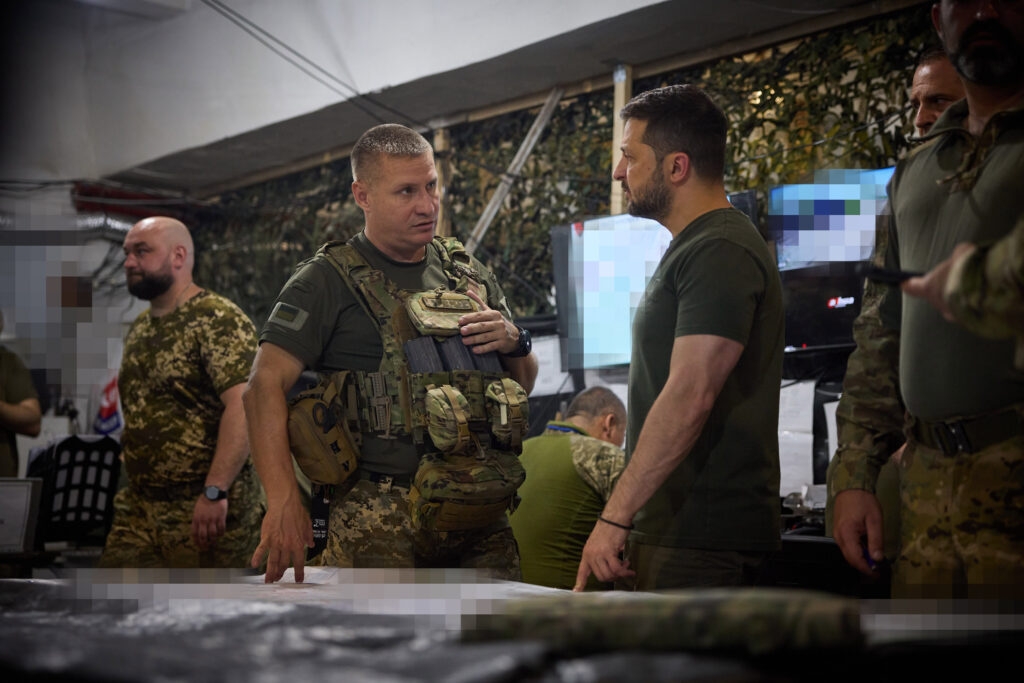
President Volodymyr Zelensky visits the Donetsk region, August 2023. (president.gov.ua)
Ukraine’s strategy is to recover its territory by attriting the Russian army and making its situation seem hopeless. This is why it wants F-16s and tactical missile systems (ATACMS). These weapons support this strategy by increasing close air support for troops trying to breach fortified lines, preventing the building of additional fortifications in the rear (as happened this winter), and striking deep into Crimea to disrupt Russian logistics. ATACMS are not wanted to recover the northern coast of the Azov Sea but the southern coast of Crimea. These weapons would have a positive psychological effect for the Ukrainians, who would see them as a sign of unwavering American support, and a negative one for the Russians, who would see their logistical problems increasing.[16] This is important as psychological factors in war can be as important as any weapons system.
Currently, the three scenarios for Ukraine’s counteroffensive are for it to either break through, gnaw through, or be stalemated. Breaking through will require breaching the Surovikin line with enough reserves to exploit success. If the Ukrainians achieve this, they might exploit the resulting chaos and quickly move through the Perekop Isthmus into Crimea. This is possible, but would require a faster tempo of operations than Ukraine has been able to generate so far. More likely, Ukraine’s army can gnaw through Russian fortifications but in doing so might use most of its reserves. A slower rate of advance could allow the Russians to conduct an orderly withdrawal behind the narrow Perekop Isthmus. To cross the isthmus, Ukraine would need more engineering equipment to breach the frontal defenses, some of which date to the sixteenth century Ottoman Empire, pontoon bridges and small boats to move through the shallow Sivash lagoon (as the Red Army did in 1920 during the Russian Civil War), and landing craft and amphibious assault vehicles to conduct shore-to-shore amphibious assaults around the littoral flanks of the isthmus. This would be in addition to more artillery and air defense assets to support and protect the operation. The final scenario is a stalemate in which the front does not move forward and attrition requires an extensive rebuilding of Ukrainian reserves. This would put the ball in Washington’s court as Kyiv hopes for support into 2024 and the Kremlin hopes that a stalemate will end such support.
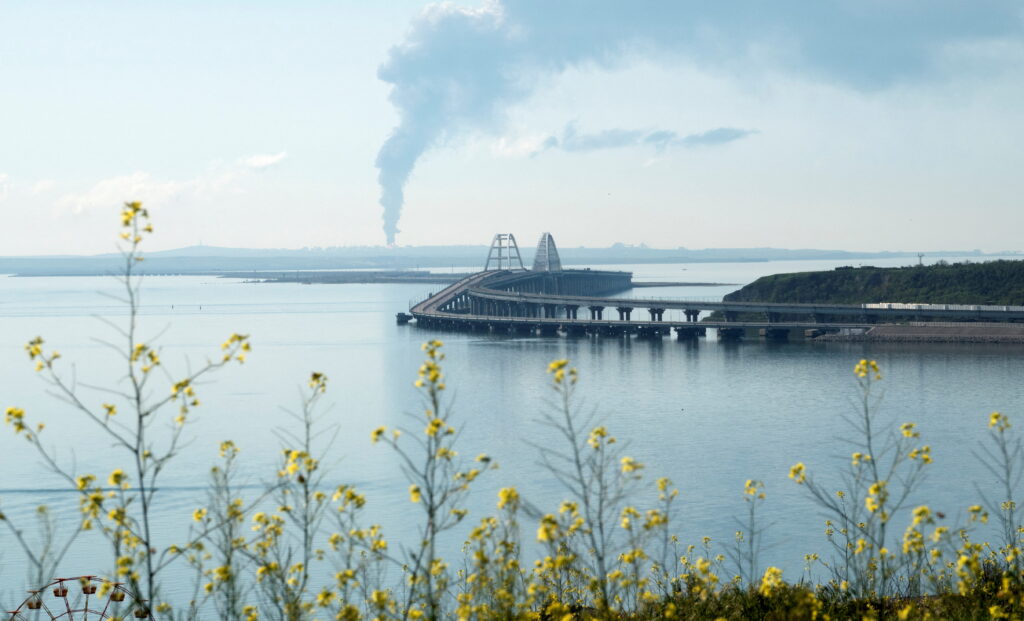
A view across the Kerch Strait shows smoke rising above a fuel depot near the Crimean bridge in the village of Volna in Russia’s Krasnodar region as seen from a coastline in Crimea, May 3, 2023. (REUTERS/Stringer)
Crimea: The Jewel in Two Crowns
Strategically and politically, control of Crimea will determine the winner and loser in this war. Russia’s illegal annexation of Crimea in 2014 was the highpoint of Putin’s rule. Losing Crimea could well lead to events ending that rule. Most Russians supported Putin’s move in 2014 and Crimea’s occupation was a source of great national pride. The fleet anchorage in Sevastopol has both military and historical significance. Without this base, Russia cannot control the Black Sea and its history of resistance in the Crimean War and World War II makes it Russia’s cultural iconic equivalent of America’s Alamo.
Ukrainians also see Crimea in geopolitical and cultural-historic terms. The peninsula is a springboard for Russian attacks and its possession allows Russia to restrict Ukraine’s maritime trade. Furthermore, after the war crimes in other occupied areas, Ukrainians fear that if Crimea is not regained soon, Russia will destroy Ukrainian and Tatar culture on the peninsula.[17]
Ukraine has already begun planning to recover Crimea. I attended a two-day conference in Kyiv from July 18–19, 2023, sponsored by several non-governmental organizations. The conference was attended by government officials and private individuals who discussed plans for the peninsula and Black Sea security once the war has ended. The general tone of the conference was that Crimea will be recovered and now is the time to start planning to reintegrate it into Ukraine. If the conflict is a holy war for Ukraine, and some Ukrainians on the street use that expression, then Crimea is their Jerusalem that “next year” they wish to be in.
Another reason why Crimea figures strongly in Ukrainian post-war planning is because many Ukrainians consider an unambiguous Russian defeat, including the loss of Crimea, as the key to ending Russian imperialism. Some conference attendees recalled how defeat and occupation in World War II cured Germany and Japan of fascism, imperialism, and militarism. Since Russia’s possession of nuclear weapons and sheer size preclude occupation, they believe that only if Russia loses Crimea, the jewel in her imperial crown, and it stays lost with Ukraine’s accession into NATO, might it reconsider its imperial nature. Ukrainians also believe that a war which ends with Russia still in possession of Crimea, is a war that guarantees that imperialism as a major feature of Russian foreign policy and national identity will continue. It is for Crimea, far more than the Donetsk and Luhansk oblasts, that Ukrainians are willing to sacrifice for a war lasting years. They also realize that the Russians might be willing to do the same.[18]
US Policy Considerations and Opportunities
US foreign policy makers need to decide for what goals and how long America intends to support Ukraine against Russia. While President Joe Biden states that the country will support Ukraine “for as long as it takes,” he has yet to articulate the exact foreign policy goals he hopes to achieve by this. After a year and a half of war, the Biden Administration is past the need for strategic ambiguity and should explain to the American people, its allies, and the Ukrainians what they can expect and make the same clear to the Kremlin. As one senior Ukrainian military official commented, “everyone says they want Ukraine to win, but no one is saying that they want Russia to lose.”
Ukraine cannot win without Russia losing; but fears of a Russian collapse or the possible use of nuclear weapons seem to drive US policy more than considerations of the opportunities that a Ukrainian victory could bring. It is often cited that the Chinese language character for the word crisis is the combination of the brush strokes for the words danger and opportunity. This combination applies to America’s Ukrainian policy. There is no way the United States can overcome the dangers inherent in this war without some element of risk and danger in its response. However, American officials should also recognize opportunities that could strengthen US security if they take advantage of them and are not deterred by their fears.
One opportunity is a Russian defeat that can serve both as a brake against further Kremlin aggression and as a catalyst for Russia to possibly change her imperial identity. Another opportunity is the chance to strengthen NATO’s conventional forces and geographic position to give it an overwhelming advantage against any possible future Russian aggression. For that to happen, Ukraine must enter the alliance.
Russian military losses in Ukraine likely preclude conventional aggression against NATO members bordering Russia for five years or more. The alliance has benefited greatly from Ukraine’s sacrifices considering that just a few years earlier many believed that NATO could not prevent Russia from seizing the Baltic states. Now many believe that defeating Russian aggression in Ukraine may deter Chinese aggression against Taiwan. Furthermore, by lessening the conventional threat to the Baltics, the United States can concentrate more against threats in the Indo-Pacific region.
Unfortunately, history shows that after every defeat, Russia rebuilds its military and regains its imperial impulses. That has been Russia’s political nature for centuries and will remain so until forced to change. A polity’s national identity is the result of how it interprets its history.[19] Russia interprets its history as a great power with a messianic mission—be it as the leader of the Communist movement or as a Third Rome. As noted earlier regarding Germany and Japan, national identity usually changes only after major disasters. Russia’s loss of Crimea could be such a disaster. Since the fall of the Soviet Union, Russia has used history and symbolism to reaffirm Russia’s imperial identity, and ignore neighbors’ different interpretations of the past. However, an imperial national identity for Russia is less credible if Ukraine remains independent. Putin is using war to deny Ukraine’s nationhood. Ukrainians are defending themselves to affirm it.
If Russia’s response to defeat in Ukraine and the loss of its ill-gotten gains in Crimea is revanche and not reform, then the need for Ukraine in NATO becomes even more imperative. Just as NATO enlargement did not cause the war, Ukraine’s accession into NATO will not be the cause of, but solution to, future Russian imperialism and irredentism. With Ukraine in NATO, there is no way Russia can succeed with future conventional aggression against the alliance. Ukraine would provide the alliance with its largest and most combat-experienced military besides the United States. By making Ukraine the eastern edge of Europe, Russian aggression westward is blocked. The recent accession of Finland into the alliance—and the prospect of Sweden formally joining NATO very soon—blocks Russian aggression from the Arctic Circle to the Baltic Sea, which is now a NATO lake. Ukrainian membership in the alliance would make the Black Sea a NATO lake, no longer vulnerable to Russian military and economic pressure. Any latent Russian imperialism will have to be directed into the Caucasus, where it will face Turkish opposition, or Central Asia, where China has already guaranteed Kazakhstan’s territorial integrity.[20] Ukraine in NATO will stabilize Europe to a point where it can be defended mostly by European ground forces and US air and air defense forces; the rest of US power can then concentrate on other threats.
If the United States pursues this policy, then the question to be addressed is not how to deal with Russian decline but how to ensure Ukrainian success—militarily, and more importantly, politically. Despite its incredible courage, problems of corruption, poor governance, press freedoms, and other issues remain. Ukrainians themselves recognize this. When I asked a pensioner if Ukraine had earned NATO membership, he replied emphatically, “The simple people YES! The bosses NO; they are all still thieves!”[21] Other Ukrainians take a more nuanced view recognizing the flaws in their society but believing that news about corruption shows a system trying to deal with the problem.
This raises the question, is Ukraine “ready” for NATO membership?
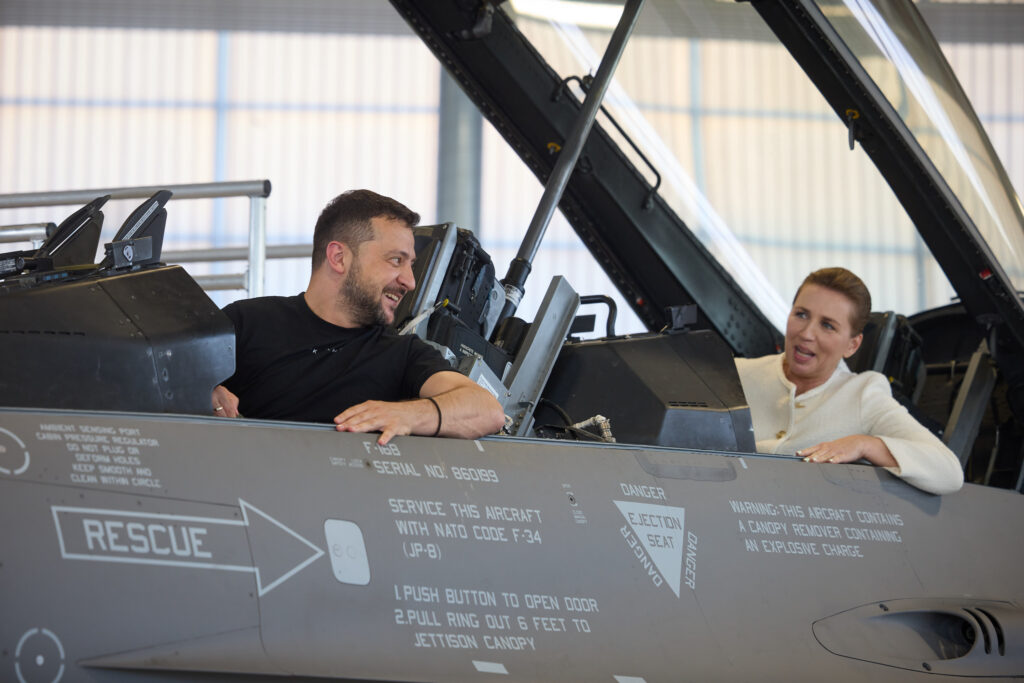
Ukraine President Volodymyr Zelensky and Danish Prime Mette Frederiksen sat in the cockpit of an F-16 fighter jet during a trip to Skrydstrup Airbase, in Denmark, on Sunday August 20, 2023. (president.gov.ua)
Ukraine is probably still far away from the NATO “ideal” that membership requires; but is it any further away than Romania, Montenegro, or even Poland were when they were admitted? Portugal is a founding member of NATO, even though in 1949 it was a military dictatorship, because the alliance needed access to the Azores to protect the Atlantic sea-lanes in case of war with the Soviet Union. Certainly, Ukraine’s democratic drawbacks are far less than those of Salazar’s Portugal. Ukraine is in transition from a proto-Soviet society to a Western one, but the West is still not fully ready to accept it. Paradoxically, Russia has rejected the West, but the West seems to refuse to accept its rejection.
US policy should be to integrate Ukraine politically and economically into the West while the country reforms and builds the institutions needed to accomplish this. Change can come in wartime. At the height of the American Civil War, Congress passed the Pacific Railway Act (1862) and the Homestead Act (1863), which set the stage for vigorous growth once the war ended. The challenge to “win the peace” will be as difficult as the challenge to win the war, but just as essential.
One question about winning the peace is can other alternatives, such as the proposed Israel or South Korea models, suffice instead of NATO membership?
In short, no. Neither model can prevent war from breaking out again. As Eliot Cohen noted in a recent Atlantic article, the “Israel model,” wherein the United States guaranteed Israel’s ability to counter and defeat any credible conventional military threat, is a dubious analogy for Ukraine and a bad idea. He noted that this policy did not arise until after Israel had defeated the Arab states in four conventional wars and had developed nuclear weapons. Ukraine’s postwar demography and economy cannot put it in the same position as Israel relative to its enemies and Ukraine gave up its nuclear weapons based, in part, on US security assurances.[22]
The South Korea model, an armistice along the current front line,[23] means a frozen conflict until one side regains enough strength to start fighting again. It is Russia’s preferred solution, has been rejected by Ukraine, and would create an unstable situation on the continent like a permanently smoldering fuse next to a powder keg. Furthermore, proponents of this option fail to recognize that what has kept South Korea safe for decades was not an armistice but the stationing there of tens of thousands of US soldiers and at one time nuclear weapons.
The final question is what if Russia breaks apart and we face the specter of loose nuclear weapons and another Russian Civil War?
Russia just might break apart. As noted in a previous FPRI paper, the loss of Crimea could lead to Putin’s downfall, political violence including even civil war, and the possible disintegration of parts of the Russian Federation.[24] The United States must prepare for this possibility and have plans to deal with the threats posed to Russia’s nuclear inventory just as we had to during the disintegration of the Soviet Union. Empires end and there is nothing observers can do about it if the empire’s rulers cannot. Despite the dangers, the end of the Russian empire would mean the end of Russian imperialism, which would be beneficial for long term stability in Europe and the geopolitical position of the United States.
The views expressed in this article are those of the author alone and do not necessarily reflect the position of the Foreign Policy Research Institute, a non-partisan organization that seeks to publish well-argued, policy-oriented articles on American foreign policy and national security priorities.
[1] Wasielewski, Philip, “The Evolving Political-Military Aims in the War in Ukraine After 100 Days,” Foreign Policy Research Institute, June 9, 2022, https://www.fpri.org/article/2022/06/the-evolving-political-military-aims-in-the-war-in-ukraine-after-100-days/.
[2] Author’s interview, July 17, 2023, Ukraine.
[3] Tharoor, Ishaan, “Putin wanted to redeem Russia’s history. He’s now haunted by it,” Washington Post, June 27, 2023, https://www.washingtonpost.com/world/2023/06/27/putin-history-1917-bolshevik-czar-revolution-crisis/.
[4] See Financial Times, “The Kremlin’s ‘Holy War’ against Ukraine,” April 19, 2022, https://www.ft.com/content/01cd44a4-a70a-4019-b4d9-df5d5a4bbd6e; Radio Free Europe/Radio Liberty, “Russian Patriarch Kirill Says Dying In Ukraine ‘Washes Away All Sins,’” September 26, 2022, https://www.rferl.org/a/russia-patriarch-kirill-dying-ukraine-sins/32052380.html; “Russia Fighting ‘Sacred’ Battle Against Satan, Medvedev Says,” November 4, 2022, https://www.rferl.org/a/russia-holy-war-satan-medvedev/32115565.html; Ellie Cook, “Russian State TV Hosts Says Russia Entering ‘Holy War Mode,’” Newsweek, January 22, 2023, https://www.newsweek.com/russian-state-television-vladimir-solovyov-ukraine-holy-war-1775589.
[5] Brennan, David, “Putin Tightens Mobilization Noose with Tenfold Hike in Draft-Dodging Fines,” Newsweek, August 1, 2023, https://www.newsweek.com/putin-mobilization-tenfold-hike-draft-dodging-fines-conscription-ukraine-reserves-1816658; Pierre Briancon, “The IMF’s outlook on Russia is too rosy to be true,” Reuters, February 10, 2023, https://www.reuters.com/breakingviews/imfs-outlook-russia-is-too-rosy-to-be-true-2023-02-10.
[6] Author’s interview, July 19, 2023, Ukraine.
[7] Author’s interview, July 19, 2023, Ukraine.
[8] Author’s interview, July 20, 2023, Ukraine.
[9] Author’s interview, July 20, 2023, Ukraine.
[10] Andrew Kramer and Steven Erlanger, “Russia Lays Out Demands for a Sweeping New Security Deal With NATO,” New York Times, December 17, 2021, https://www.nytimes.com/2021/12/17/world/europe/russia-nato-security-deal.html; Gabrielle Tetrault-Farber and Tom Balmworth, “Russia demands NATO roll back from East Europe and stay out of Ukraine,” Reuters, December 17, 2021, https://www.reuters.com/world/russia-unveils-security-guarantees-says-western-response-not-encouraging-2021-12-17/.
[11] Lenta.ru, “Это чревато катастрофическими иоследствиями” Сергей Лавров – о конфликте с НАТО и рисках применения ядерного оружия [“This is fraught with catastrophic consequences” Sergey Lavrov on conflict with NATO and the risks of using nuclear weapons], July 12, 2023, https://lenta.ru/articles/2023/07/13/lavrov/.
[12] Author’s interviews, July 17-18, 2023, Ukraine.
[13] Author’s interviews, July 17-21, 2023, Ukraine.
[14] Vladislav Inozemstev, “Putin’s Deathonomics,” Riddle Russia, July 11, 2023, https://ridl.io/putin-s-deathonomics/.
[15] Author’s interviews, July 17–18, 2023, Ukraine.
[16] Author’s interview, July 18, 2023, Ukraine.
[17] Author’s interviews, July 19, 2023, Ukraine.
[18] Author’s interviews, July 19, 2023, Ukraine.
[19] Ilya Prizel, National Identity and Foreign Policy (Cambridge: Cambridge University Press, 1998), 14.
[20] Lily Kuo, “China’s Xi Visits Central Asia Ahead of Expected Meeting with Putin,” Washington Post, September 14, 2022, https://www.washingtonpost.com/world/2022/09/14/china-xi-putin-meeting-kazakhstan-uzbekistan/.
[21] Author’s interview, July 16, 2023, Ukraine.
[22] Eliot Cohen, “The ‘Israel Model’ Won’t Work for Ukraine,” The Atlantic, July 13, 2023, https://www.theatlantic.com/ideas/archive/2023/07/israel-model-ukraine/674683/.
[23] Carter Malkasian, “The Korea Model: Why an Armistice Offers the Best Hope for Peace in Ukraine,” Foreign Affairs, June 20, 2023, https://www.foreignaffairs.com/ukraine/korean-war-diplomacy-armistice-nato.
[24] Philip Wasielewski, “Will Russia Survive Until 2084?”, Foreign Policy Research Institute, December 20, 2022, https://www.fpri.org/article/2022/12/will-russia-survive-until-2084/.




